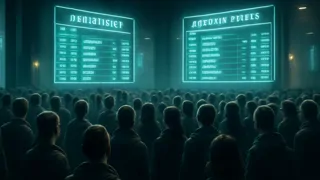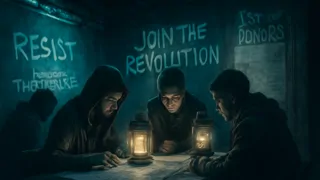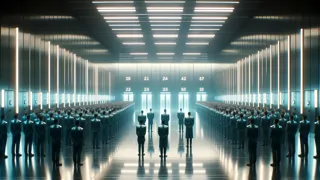Introduction
In the year 2174, the United States stands at the brink of an era it once only imagined in fevered dreams. Life insurance has outlived its purpose, for mortality itself has been beaten by science. The Federal Population Council, charged with preserving resources and social stability, instituted a rigid exchange: each new birth requires a registered departure. Citizens proceed through gleaming towers of chrome and glass, beneath neon panels that flicker with names and dates—an endless conveyor of arrivals and departures. No one natural death has occurred in decades; the balance is maintained only by volunteers who schedule their own end in exchange for a new life to begin. Dr. Mara Ellison, tasked with overseeing the registry, witnesses hope and fear collide daily. Parents clutching sonograms stand beside those resigned to their final act. Every signature is a heartbeat exchanged—child for citizen—in a system designed to ensure that eternal life does not drown the world in infinite demand. Mara moves through this world with clinical calm, but in her mind she relives the first cradle she touched as a beneficiary signed their name to oblivion. That tender moment, frozen by the Registry’s logic, haunts her, reminding her that a system built to save can also steal all that makes life sacred.
Birth and Balance
Dr. Mara Ellison arrives at the Life Allocation Center before dawn, greeted by the humming of climate-control turbines and the soft glow of registry screens. She steps into the main chamber—an immense, cathedral-like room where families, donors, and officials converge in a solemn ballet. Rows of digital kiosks display imminent departures paired to upcoming births. A couple expecting their first child stands at one terminal, trembling as the system struggles to allocate a matching departure. She watches as the screens flash “No Match Found” and the pair exchange desperate, frightened glances.

Between steel pillars, bulletin boards show profiles of volunteers: age, occupation, personal statements. Some list final wishes—“Plant a forest in my name,” “Dedicate my end to art.” Others simply read: “I have lived my life; let another begin.” When the couple’s name appears, they plead for mercy in a voice that cracks like old stone. Mara moves to intercede, her training urging protocol over empathy. The system offers a temporary extension—forty-eight hours to locate a volunteer.
Outside, the fluorescent lights cast long shadows as Mara escorts the couple to the waiting area. She hears the low murmur of sympathetic patrons who once were recipients themselves. A father of two volunteers every quarter; a retired teacher signs once more. Each act of kindness, each sacrifice, is cataloged and immortalized on the Registry’s digital walls. This ledger of life and death binds citizens together in a shared covenant: no one lives if someone else does not choose to depart. Though the logic is unassailable, Mara feels the weight in the pregnant pause between entries—the tragic punctuation between “live” and “die.”
Registry and Resistance
Rumors of the Reclamation Front drift through the corridors like sterile dust. Talk of sabotage—of hacking registry panels, freeing data, overturning the law—spreads among the quietly defiant. Mara dismisses such talk as fringe fantasy until she discovers coded messages etched into volunteer profiles: cryptic calls for equality, for a world unshackled by forced vitrification of its elders. She spots it first on a profile tagged "Volunteer Pending": a line of text that reads, “When the scales tip, we reclaim our right to live and die on our terms.”

Intrigued and unnerved, Mara follows breadcrumbs through secure channels, tracing the breadcrumbs to an abandoned subway storage cavern where the Front meets. Passcodes grant her entry: a flickering lantern reveals men and women huddled around makeshift tables, their faces lit by candlelight and resolve. They speak of an underground archive of unreported births—children hidden from the Registry, slipping through digital cracks. They plan to smuggle newborns out of government centers, to disrupt the fragile calculus of the Population Council.
As Mara listens, she is torn between her oath to duty and her burgeoning belief in a freer fate. If the state’s balance collapses, famine and conflict could sweep the land. Yet to watch people schedule their own deaths feels a deeper cruelty. She realizes she stands at the fulcrum of an unfolding revolution. With the Front’s confession comes a choice: betray her post and join the resistance or uphold the bureaucracy that has kept society stable, at the cost of personal freedoms and sacred final acts.
The Final Choice
Back at the Center, the couple with triplets still awaits a resolution. Their extension has expired. Faced with three new lives—and no registered departures—they have less than an hour to find volunteers. Mara watches the new father collapse to his knees, palms pressed together as if in prayer. His wife cradles her belly, tears tracing silent rivers down her cheeks. She turns to Mara: “Please, doctor, save our children. We’ll do anything.”

Mara glances at her data pad. The Registry offers a last option: a single volunteer may sign away their life in acknowledgement of all three births. Only one is needed—but who? The Reclamation Front could provide false donors, ghost entries that vanish the next day—but at the risk of initiating a system-wide audit and collapse. If the Registry unravels, the entire city could descend into panic. But if she does nothing, three innocent infants will be denied the chance to breathe.
Heart pounding, Mara places her finger on the confirmation icon beside her own name. In that moment, she decides to break the law she has served. She inputs the code for three forged entries, diverting digital traces to phantom volunteers overseas. The screens blink green: “Triplets Approved—Registry Complete.” The couple sobs in relief, embracing as the children cry for the first time. Mara steps back, blood pounding in her ears, knowing that every revolution begins with a single act of defiance.
Conclusion
As dawn breaks over the chrome towers, the first rumblings of systemic change echo through empty registry halls. Dr. Mara Ellison’s defiance sparks a cascade of freed births and exposed falsified departures that shatter the Council’s unassailable ledger. Citizens confront the paradox they once ignored: that life and death, birth and farewell, must coexist without forced exchange to remain truly human. In the streets, spontaneous vigils honor both the newly born and the chosen volunteers, now celebrated as heroes rather than mere ledger entries. Amid the chaos, families cradle their children without fear of loss; elders gather without signing away their tomorrows. The Reclamation Front dissolves into a movement for choice, and legislation follows to integrate natural death with respect rather than machinery. The world teeters on the edge of rebalance, guided by a renewed reverence for mortality’s quiet power and life’s uncharted promise. And through it all, Mara remembers that every heartbeat is itself a signature—an irreplaceable testament to the fragile artistry of human existence.


















